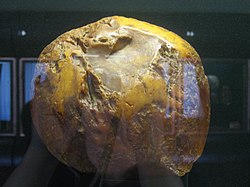Palanga Amber Museum
[2] Amber workshops appeared in Palanga during the 17th century; guilds devoted to the material functioned in Brügge, Lübeck, Danzig, and Königsberg.
[2] In 1897 Feliks Tyszkiewicz, a member of an old Ruthenian/Lithuanian noble family that had long had a presence in Palanga, built the Neo-Renaissance-style palace that now houses the museum.
The museum holds Europe's third largest amber specimen, the "Sun Stone", of size 210x190x150 mm and weighing 3,526 grams, which has been stolen twice.
The cultural and artistic exhibits include a 15th-century ring, a 16th-century cross, and amber jewelry from the past four centuries,[2] as well as a number of rosaries, cigarette holders, and decorative boxes.
Selections of modern amber work are part of the collection, including pieces by the Lithuanian artists Horstas Taleikis, Dionyzas Varkalis, Jonas Urbonas, and others.
[3] The park features a rose garden, greenhouse, rotunda, a sculpture of Eglė, the Queen of Serpents, a Holocaust memorial, ponds, and gazebos; during the summer it hosts concerts and festivals.
[12] According to legend, this dune is the place where Grand Duke of Lithuania Kęstutis met his wife Birutė, a pagan priestess, and where she is supposed to have been interred in 1382; it has been a pilgrimage site ever since.

